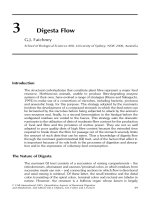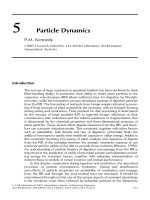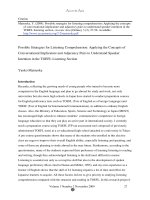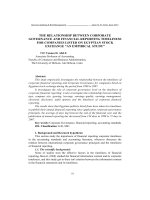Clarifying some cultural aspects of giving compliments and some suggest implications for english teaching in high schools
Bạn đang xem bản rút gọn của tài liệu. Xem và tải ngay bản đầy đủ của tài liệu tại đây (134.09 KB, 15 trang )
THANH HOA DEPARTMENT OF EDUCATION AND TRAINING
BAC SON HIGH SCHOOL
EXPERIENCE INNOVATION
CLARIFYING SOME CULTURAL ASPECTS OF GIVING
COMPLIMENTS AND SOME SUGGEST IMPLICATIONS FOR
ENGLISH TEACHING IN HIGH SCHOOLS
Writer: Đinh Văn Thiện
Position: Teacher
Topic in the fields of: English
THANH HOA 2016
1
INDEX
CONTENT
Page
A. INTRODUCTION
3
I. Reasons to choose the theme
3
II. Aims of the research
3
III. Subjectives of the research
4
IV. Scope of the research
4
V. Methodology of the research
4
B. CONTENTS
5
I. Theoretical basis of the study.
5
1. Compliment function
5
2. Basic rules
5
3. Giving compliments
6
4. Data analysis and disscussion
7
II. Reality of the issue
9
1. Advantages
9
2. Disadvantages
9
3. The practical basics of the theme.
10
C. CONCLUSION
14
1. Conclusion
14
2. Proposal
14
REFERENCE
15
CONVENTIONS OF ABBREVIATIONS
15
2
A. INTRODUCTION
I. Reasons to choose the theme
As polite expressions conveying appreciation and admiration towards others,
compliments are easily found in our daily lives. Giving a compliment is an
extremely simple but a highly effective way in communication. Actually, it is not
always successful. Despite the same positive intentions of compliments, the
differences in linguistic and cultural settings may lead to mutual incomprehension
among foreign conversational partners. For example, Vietnamese people might not
find the compliments on their little children appropriate without the phrase “trộm
vía” whereas it may be difficult for an English to understand why Vietnamese
prefer downgrading or denial to response to compliments.
Further more, the mutual incomprehension appears not only among foreign
conversational partners but also among the communicators who share a common
language. We can learn from the following situation:
On Nam’s birthday, many attendants persuaded Lan to sing a song but her
voice was not very good. After having tried to finish, Minh talked to everyone with
a clear voice: “Đó là giọng hát hay nhất mà tôi đã từng được nghe! Tại sao Lan
của chúng ta không tham gia cuộc thi Sao mai điểm hẹn nhỉ? Tớ nghĩ bạn ấy sẽ
giành giải nhất.” As soon as Minh stopped to talk, some smiled, some even
laughed and others kept silence while Lan appeared to be very disappointed. Then
what is wrong with Minh’s compliment?
Giving compliments is an art and complimenters are really artists. In other
words, suitable compliments are not easy for us to give, especially high school
students who need to understand them in both Vietnamese and English.
Unfortunately, the materials or researches concerned with this theme are
unavailable. Therefore, in order to reduce the chance of such misfortune and assure
the effectiveness of their communication, obtaining some basic knowledge about
the art of giving compliments in Vietnamese culture is an indispensably important
factor. For that reason, I, in my efforts, try to concentrate upon the topic to enhance
learners’ language competence as well as to help them overcome the difficulties
they encounter during their learning.
II. Aims of the research
In my study, I would like to present systematically issues of the definition,
function, strategies and patterns of giving to compliments. There are some
comparisons to help students master the difference in language meanings which
results from the cultural differences. In that way, they would not only know the
proper ways of complimenting but also would be able to avoid the inappropriate
expressions. Being provided with a detailed series of structures and the instruction
3
how those structures work, students can easily apply them to their real life
conversations.
III. Subjective of the research
Basing on the fact of teaching and learning English through each year for high
school students, especially students in mountainous areas, I have understood
students’ problems and difficulties in their learning process to gain the knowledge
and competence cultural aspects in high school textbooks. Therefore in this topic, I
studied the fundamental solutions applied to my students in Bac Son High School,
who are mostly at low level of English.
IV. Scope of the research
With the topic “Clarifying some cultural aspects of giving compliments and some
suggest implications for English teaching in high schools”, my research is focused
on the theoretical background of compliments and discussion to similarities and
differences between cultural aspects of giving compliments in Vietnamese and
English with some possible explanations. In general, the speech acts focused is
“giving compliments” and the context is high school-talk nowadays.
V. Methodology of the research
In this research, I have collected and integrated several different sources of
information to create an informative and concise presentation.
Firstly, I had to find any documents related to the topic. As there were few text
books and researches concerned with compliments in the libraries or bookshops, I
had to make use of the sources on the internet. I only focused on some online
journals which included international recognized researches to contribute to my
study.
Next, after collecting needed information, I have had some short conversations
with some high school students to see what they needed when giving compliments
in their daily lives. Especially, through this conversation, I also could come up with
some interesting examples to clarify the main points in my orientation.
4
B. CONTENTS.
I. Theoretical basis of the study.
1. Compliment function
According to Nguyen (2005, p.568) a compliment is sometimes more than a
compliment. However, in everyday life, people usually compliment others not only
to praise them but also to achieve some special goals which are called compliments
functions which have been listed by Nguyen (2005, p.568-569) as request for help,
suggestion, gratitude and encouragement.
For example:
“You look great in your skirt. Why don’t we go down the town for
sightseeing?”
In the above compliment, the complimenter wants to address his or her primary
intentions to go sightseeing. This way of speaking is widely used among the
Vietnamese and is adopted by Vietnamese learners of English.
2. Basic rules
In cultural communication in Vietnam as well as in English, there are some
basic rules that they should respect to be more successful in giving compliments.
Be polite
Give more than
receive
Be various
Avoid flattery
a, Be polite: To put more value and truthfulness in a compliment, the
complimenters should be as polite as possible. The same go for receiving
compliments. The speakers will think that the hearer really appreciates what they
are talking about.
5
b, Be various: A golden key when giving compliments is the variety. People should
compliment differently in many situations, or respond the others’ compliment
creatively. That will show the respect to the other side.
c, Avoid flattery: When giving compliments, the complimenters should base on the
reality. A too exaggerated compliment is not as welcome as a modest but exact one.
d, Give more than receive: the poverty in giving a compliment will become a
hindrance when a foreigner tries to get in harmony in Vietnamese society. Thus,
giving many more compliments would be such a good strategy to improve his or
her relationship with Vietnamese people.
3. Giving compliments
3.1. Strategies of giving compliments
There are two main parts in the strategies, which are topics for compliment and
tactics of complimenting.
3.1.1. Topics for compliments
Appearance, posession, ability and accomplishment are common topics for
complimenting.
Similar to English speakers, Vietnamese often commence a friendly
conversation by giving compliments on other’s appearance, especially when that
person has something new or different such as a new haircut, new car. Belongings
such as shoes, hats, or houses, etc. are also suitable subjects for compliments.
For example:
Giầy đẹp thế! (Nice shoes!)
Nevertheless, positive compliments on appearance of babies or small children
should be delivered carefully. Traditionally, Vietnamese people, especially the
elderly, regard compliments using positive adjectives for young child may bring
mishap to him/her. Hence, Vietnamese often add “trộm vía” that is used more
typically for the Vietnamese Northerners to the compliment or using indirect
expressions (negative adjective with positive attitude):
For example:
“Nói trộm vía cháu, độ này nó mập lắm”
(which means “My child has gained a lot of weight”).
For the compliment on ability and accomplishment, Vietnamese people often
focus more on talent and skill rather than the result or product. For instances, if you
want to praise a man for his painting talent, the expression “Anh vẽ đẹp quá!” (You
draw so well!) sounds more straightforward, sincere and the complimentee would
feel prouder.
For both topics, the complimenters should always mind their attitude, facial
expressions and intonation in order not to create the wrong impression of
superiority or irony.
6
3.1.2. Ways to compliment
a) Explicit compliment
According to Cambridge advanced learner’s dictionary, explicit means “clear
and exact”. Explicit compliment can be understood as “direct praise to the target”.
For example:
- Cô ấy xinh thật! (She’s so beautiful!)
b) Implicit compliment
On the other hand, “implicit” means suggested but not communicated directly.
Thus, implicit compliment means indirectly praise. This type of compliment can be
offered by some ways such as comparing to the speaker’s him/ herself or
questioning.
For example:
- Sao mà bạn chơi hay thế? (How could you play so well?)
3.2. Patterns of giving compliments
According to Maines and Wofson (1981), there are nine popular ways to give
compliment:
- NP is / looks really Adj. (Your hat is really beautiful)
- I really like/love NP. (I really like your house)
- Pro is (really) (a) Adj NP. (That’s a really nice reading lamp.)
- You V (a) really Adj NP. (You did a really good job.)
- You V (NP) (really) Adv. (You really did that assignment well.)
- You have (a) Adj NP. (You have a such beautiful voice.)
- What a Adj NP! (What a lovely face you have!)
- Adj NP ! (Excellent game !)
- Isn’t NP Adj (Isn’t your phone beautiful?)
The first three are also the most widely used structures in many countries
worldwide, including Vietnam. One difference, nevertheless, is that unlike English,
Vietnamese usually use the second person pronoun instead of the first person
pronoun in their compliments (Dang, T. T. N., p.5). Therefore, instead of saying “I
really like your new hair style”, it is more appropriate to say “Your new hair style
is nice”.
Besides, there are many other ways to give compliments in Vietnamese
language. They are categorized according to their sentence types: statements,
exclamations and questions.
4. Data analysis and discussion
4.1. Data analysis
There are many definitions of compliment. According to Cambridge dictionary,
a compliment is defined as “a remark that expresses approval, admiration or
respect”. In linguistics, Holmes (1986, p.446) indicated that a compliment was
7
used to “explicitly or implicitly attribute credit to someone other than the speaker,
usually the person addressed, for some ‘good’ (possession, characteristic, skill,
etc.), which is positively valued by the speaker and the hearer.” In other words,
giving compliments is considered giving positive comments on others for their
good characteristics, good skills, or good possessions….
4.2. Discussion
4.2.1. Similarities
As mentioned above, a compliment is defined as a remark that expresses
approval, admiration or respect. As a result, there are many resemblances in
cultural aspects of giving compliments in Vietnamese and English.
Firstly, in both English and Vietnamese, communicators tend to use explicit
compliments that can be understood as “direct praise to the target” to their
conversational partners
For example:
- Cô ấy hát hay thật ! (She sings really well!)
Sometimes, they also apply encouragement compliments for their conversation in
which the complimenters to address their primary intentions to do something.
For example:
- Chữ viết tay của em tuyệt đấy, cứ tiếp tục phát huy nhé !
(Your handwriting is excellent, keep up your good job!)
Lastly, the complimenters’ attitude, facial expressions and intonation play
important roles in succeeding in giving compliments. They decide the wrong
impression of superiority or irony to the complimentee even though the
compliment is perfect in linguistic aspect.
4.2.2. Differences
Differences in culture often create many distinctions in conversational
understanding between the communicators. Giving compliments is a sample that
cannot be similar between English and Vietnamese. Due to English tends to
simplicity, English people often use explicit compliments in their conversation
whereas the Vietnamese prefer delivering implicit ones to express their feelings.
For example:
To praise a woman for her cooking talent,
- English people: “You cook very well!”
- Vietnamese people: “Chị nấu ăn giỏi thế?” (How could you cook so well?)
Besides, positive compliments on appearance of babies should be delivered
carefully in Vietnamese conversational culture. Traditionally, they regard
compliments using positive adjectives for young children may bring bad luck to
him/her. Therefore, “trộm vía” is often added to the compliment by complimenters,
especially the Northerners in Vietnam.
8
Last but not least, exclamation, one of the patterns of giving compliments,
probably contains many differences in complimenting between Vietnamese and
English because of its structure added with “quá/lắm/thế/thật/nhỉ/đấy/ghê/phết” at
the end of the sentence. Hence, it sometimes causes a lot of difficulties for the
language learners to apply fluently these words for their compliments.
II. Reality of the issue
1. Advantages
Complimenting is a such practical and interesting topic that most of students
and even teachers would like to discover.
Further more, although many problems directly affect to the teaching and learning
process, our teachers and students have overcome the difficulties and have
gradually improved the quality of English teaching to meet the constantly changing
requirements of the textbook programmes.
• For teachers:
- They have absorbed initially to new teaching methods.
- They have constantly improved knowledge and learned experiences from each
other to promote the quality of teaching.
• For students:
- Most of them participate regularly and positively in learning English.
- They are always interested in learning new teaching methods.
2. Disadvantages.
Most of the students in High School are embarrassed when they are asked to
give compliments in English. This would have been also the remarkable interest of
the teachers who are teaching these students to learn English.
A survey was proceeded to find out factors leading to this problem, perhaps
followings are some major difficulties:
2.1. Time to perform the research
Being considered as an extra-activity, the research is not planned into schools’
curriculum, whereas its performance for each class is indicated at least fifteen
minutes. This orders teachers to choose the suitable time to carry out the study in
effective ways.
2.2. References
Despite an interesting topic, complimenting is quite scarce to search on most of
resources.
2.3. Background of compliments
As mentioned above, giving a compliment is simple, but a true one is a really
difficult issue since the fact that many people do not have enough basic knowledge
of it.
2.4. Level of target language
9
Students usually have difficulties in giving a reasonable compliment in English
because not only their vocabularies are poor but also many structures concerned
with complimenting are really strange to them.
3. The practical basics of the theme.
3.1. Solutions
Based on the reality of the issue, I would strongly suggest some following
solutions to the problems:
3.1.1 Time
There are correction periods after tests in the curriculum. Normally, we cannot
use up the time to do the tasks in these periods. This is a good chance for teachers
to indicate the research. Because the minimum time of the research is about fifteen
minutes, teachers can carry out it either totally or partially depending on the last
time of that period and the learners’ level.
3.1.2. Procedure of complimenting
Teachers can use their own favorite methods in which they have to the
background knowledge that mentioned above and some particular situations in
which express giving compliments in English and Vietnamese below:
Situations of Vietnamese
English
compliments
Request
for Tuan! Cậu rất Tuan! You are
help
hào phóng, ngày very generous,
mai cậu đưa could you please
mình
đến take
me
to
trường
được school
không?
tomorrow?
Gratitude
Tao chưa thấy ai You are the
nhiệt tình như kindest person
mày! Cám ơn I’ve met, thank
nhé!
you very much!
Ability
and “Bạn hát
accomplishmen quá!”
t
Analysis
This way of speaking is
widely used among the
Vietnamese and English
communication
This way of speaking is
widely used among the
Vietnamese and English
communication
hay You sing so well!
This way of speaking is
widely used among the
Vietnamese and English
communication
Encouragement Bài văn này em Your essay is This way of speaking is
làm tốt đấy, cứ excellent, keep widely used among the
tiếp tục phát up your good Vietnamese and English
10
huy nhé!
Appearance
and possession
Statements
Exclamations
job!
communication.
“Con chị nhìn “The baby is so Traditionally, Vietnamese
thấy ghét quá”
cute”
people, especially the
“Your baby is
elderly,
regard
not cute at all”
compliments
using
positive adjectives for
young child may bring
bad luck to him/her.
Therefore, they often
add “trộm vía” to the
compliment or using
indirect
expressions
(negative adjective with
positive attitude)
Ước gì người Your boyfriend is In this way, if the
yêu tớ ga lăng very gallant .
compliment conveys so
như bạn.
much feeling from the
I
wish
my
speaker it might sound a
boyfriend were
little fake to the listener.
as gallant as you
Hôm nay bạn How
beautiful These structure adding
trông xinh lắm! you are today!
“quá/lắm/thế/thật/nhỉ/đ
Bạn đá bóng What a great ấy/ghê/phết” at the end
the
sentence
siêu thế!
footballer
you of
sometimes
cause
are!
Thầy giáo dễ How easy-going difficulties to Vietnamese
learners as well as
tính thật!
the teacher is!
foreign
conversational
Bạn làm việc How
chăm chỉ ghê!
hardworking you partners
are!
Trông cậu xinh You
look
as
như hoa ấy!
pretty
as
a
flower.
Nhà bạn hoành How glamorous
tráng phết!
your house is!
Nhìn thế mà How skillful you
11
Rhetorical
questions
Implicit
compliment
khéo tay gớm!
Mày học thế
nào mà siêu
thế?
are!
You learn so well. These questions only aim
How do you do at showing the speakers’
it?
appreciation towards the
listeners, not at seeking
any particular answer
Tớ còn lâu mới I have to try a lot The complimentor does
được như cậu
to catch up with not
compare
but
you
indirectly praise the
complimentee
Although whichever pattern is used, the compliment may turn out to be too
flattering or impudent to the complimentees if it is given in an inappropriate
context, on an indelicate object or with a conflicting attitude expressed in the
complimenters’ tone, facial expression and gestures. For that reason, in my point of
view, apart from the strategies and patterns, the vital key to a heart-winning
compliment is nothing more than the complimenters’ own sincerity.
3.1.3. Practice
Teachers should give some real situations to expect students’ responses then
correct them in two ways:
- Student practices teacher corrects
- Student practices the partner corrects
SITUATIONS:
1. You are a good student in a high school. Your mother is a very caring woman
who takes care of you and help you a lot in your living as well as your study. How
can you express to compliment her?
2. What is the power of a true compliment?
SUGGESTED ANSWERS:
1. At the time my mother feels relax, with my sincere attitude expressed in my
facial expression and gesture, I will say: “- Mum, you’re the most wonderful
mother. I love you so much. ”
2. If you give a true compliment to the other, you will receive more than a
compliment. It can help you not only bettering the relationship but also easily
succeed in your business involved the complimentee. Moreover, by a sincere
compliment, the complimentee might forgive some mistakes that the complimenter
made to him or her before.
3.2. Experimental results
3.2.1. Prominent achievement
12
Extra-activities often cause students exciting to do because of their practicality
and flexibility. Teaching complimenting is a sample.
After conducting the research for some classes, most of students have
conceived the value of compliments from the partner. They are also willing to give
compliments when they feel it is necessary. In addition, due to the performance of
the study, students’ vocabularies, structures and skills concerned with
complimenting are improved remarkably.
3.2.2. Pedagogical implications
The research on distinctions and resemblances in cultural aspects of giving
compliments in Vietnamese and English reveals one prominent effect of the
cultural factor on communication which specifically contains the situations where
compliments are involved. Basically, when two cultures cross, a number of
differences emerge in all aspects. Understanding the culture of this verbal
communication will help recede the possibility of confusion, misconception or any
other types of communication breakdowns. As shown in the previous parts, the
cultural factors make the way of giving compliments in Vietnamese culture
remarkably different from that in English culture. This might be expressed clearly
through the differences in the ways of thinking, lifestyles, traditions and naturally,
the cultures of the two nations. The research not only provides high school students
with useful guidance and tips, but also familiarizes them with contrastive analysis
in Vietnamese cultural communication vs. English ones.
13
C. CONCLUSION
1. Conclusion
Complimenting is a part of culture where verbal factor is concerned a lot. It is
commonly used in daily life as a communication tool which helps to build the
relationship among people by showing admiration and gratitude toward each
others. Therefore, in order to blend in well with a society, knowing how to giving
compliments is really important.
This is also supposed to be an orientation for high school students who are
making their efforts to study English for their own aims. As a presenter, I have
systematically listed out the definition, function, strategies and patterns of giving
compliments. There are some comparisons to help students be more aware of the
differences in language meanings which result from the cultural differences. In that
way, they would not only know the proper ways of complimenting but also would
be able to avoid the inappropriate expressions. Being provided with a detailed
series of structures and the instruction how those structures work, students can
easily apply them to real life conversations.
2. Proposal
As the role of the main guider, teachers need to be aware of their
responsibilities in each task and especially emphasis on their own plans before
coming to class.
Because the fact that the arrangement of time to conduct the study often has
difficulty, teachers should divide it into parts to fit the time and their students’
level.
Focusing on cultural aspects of giving compliments , my research cannot
bring the success for perfect complimenting. Therefore, I look forward to learning
the other research for other aspects of this issue.
The suggested solutions mentioned above experienced by myself accompanied
my colleagues through our teaching brought positive results than we had done
before. However, the innovation of teaching field is a long process and it is hard to
fit well with all kinds of students. Thus, I would like to receive the comments and
the exchange of ideas from you who have the passionate enthusiasm in the
development of Vietnam education.
Identity of the headmaster
Thanh Hoa, 20th April 2016
I make sure that this experience innovation
was done by me.
14
Đinh Văn Thiện
REFERENCE
Dang, T.T.N. (2009). A contrastive analysis of compliments in American English
and Vietnamese. Retrieved November 15th 2010 from the World Wide Web:
www.eric.ed.gov/ERICWebPortal/recordDetail?accno=ED039526
Holmes, J. (1986). Compliments and compliment responses in New Zealand
English. Anthropological Linguistics, 28(4), 446.
Manes, J. & Wolfson, N. (1981). The compliment formula. In F. Coulmas (Ed.),
Conversational routine (pp. 115-132). The Hague: Mouton.
Nguyen, T.D. (2005). Giving and Receiving Compliments: Viewed from Textbooks
and Respondent. Proceedings of the International Conference on Critical
Discourse Analysis: Theory into Research, November 2005, 568-569.
CONVENTIONS OF ABBREVIATIONS
N
Adj
Adv
V
NP
Pro
noun
adjective
adverb
verb
noun phrase
pronoun
Danh từ
Tính từ
Trạng từ
Động từ
Cụm danh từ
Đại từ
15









